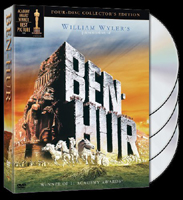 BUY IT AT AMAZON: CLICK HERE!
BUY IT AT AMAZON: CLICK HERE!
STUDIO: Warner Home Video
MSRP: $39.92
RATED: G
RUNNING TIME: 222 Minutes
SPECIAL FEATURES:
• Audio commentary by film historian T. Gene Hatcher w/ Charlton Heston
• Music-only track
• 1925 silent version from Turner Entertainment Co.
• Ben-Hur: The Epic That Changed Cinema documentary
• Ben-Hur: The Making of an Epic documentary
• Ben-Hur: A Journey Through Pictures featurette
• Screen tests
• Vintage newsreels gallery
• Highlights from the 4/4/60 Academy Awards ceremony
"Epic"
is a word whose meaning has mutated dramatically since its inception. Take any college
survey class of the original epics, such as The
Iliad, and you’ll find common attributes that are the genetic makeup of the
epic: true heroes with tragic flaws, actions with far-reaching ramifications,
and the direct influence of gods.
By these
standards, Ben-Hur isn’t an epic at all, but with our society’s literary
obsession with character development, it’s the closest we can get. It has been described
as "the first intimate epic," and that’s not half-bad terminology. It
set the standard for what
and Gladiator.
It did so with grace and a poignant attitude appropriate for a film subtitled
"A Tale of the Christ." Judah Ben-Hur is not a hero like those the
Greeks adored; his tragic flaw is not insurmountable, because the audience
becomes, in a sense, intimate with the character, more so than with any of the
heroes in Homer’s poems. His actions have wide consequences, but they are small
in scope, mere political shakeups. And instead of gods, the film features only
the man Jesus, acting quietly whenever his path crosses with
single man.
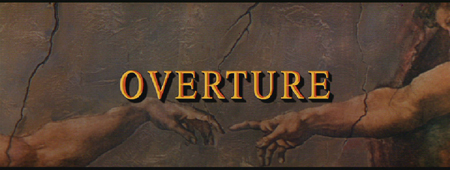
It didn’t take long before God was once again making overtures toward Adam. Incorrigible.
The Flick
The
novel, Ben-Hur: A Tale of the Christ,
was written in 1880 by General Lew Wallace, a former civil war soldier. He has
been described as being neither a man of peace nor a man of religion, so it’s
ironic that he would compose such an enduring story of redemption and paean to
nonviolence. It was written at a deliberate pace over seven years, reportedly
as Wallace reclined under a beech tree in his garden.
This
pacing is preserved in William Wyler’s (Roman Holiday, Funny Girl) 1959
adaptation, which was only one of many. Wyler spends significant time
establishing location and scale, emphasizing the grandeur of the setting while
simultaneously reining in a plot that has the potential to devolve into a
breakneck revenge drama.
Charlton
Heston plays Judah Ben-Hur, a prince of
under the Roman occupation of his lands; he is wealthy and well-respected in
his community. His house is large and ornate, his clothes are fashionable, and
his mother and sister are happy in his household.
The Roman
occupation is going through mild political turmoil, and the local tribune is
being replaced by a ferociously ambitious man named Messala. Judah and Messala
were friends as children — closer to brothers, in their own words — until
Messala left
in which he grew up, Messala hopes to impress his superiors by putting down the
murmurs of rebellion that are swirling in the region. To this end, he tries to
enlist
bitter, as
Messala, to betray his own people to an unjust occupying force.
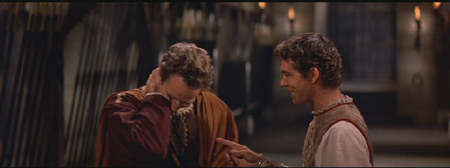
"You said it was to be a secret kiss!"
Soon
after, as
governor from the roof his house, his hand slips and sends a clay shingle
crashing to the ground, startling horses and wounding soldiers. It’s the barest
of accidents, but Messala seizes upon the chance to revenge himself against his
former friend. Covering his anger behind the self-importance of a politician,
he explains to Judah that he is being punished not for the accident but so that
he will stand as an example to rebels that the might of Rome is yet strong in
Judea.
chained to an oar for the rest of his life, while his mother and sister are
consigned to a dungeon.
Anything
sound at all familiar? This plot is not a paragon of uniqueness, but rather an
absolutely believable progression of actions we entertainment junkies are well
familiar with. The maligned protagonist is now trampled by injustice, and there
seems to be no way for him to right the wrongs that have been done to him. I
bite a little at the cliche, but this is the sort of scenario that is
consistently compelling to audiences. Here, it is made even moreso by the spare
and beautiful dialogue. Not a single line is wasted, and every word is
forceful. Occasionally, Ben-Hur breaks the axiom of
"show, don’t tell;" but I don’t mind, because it is told so well.
With
plotting his revenge even as he bakes to death on the long march to the sea, he
meets his buddy from the subtitle. This is a scene worthy of focus, because it
is nearly wordless, except for the gruff barks from the Roman guards. As the
guards water themselves and their horses, the slaves are denied any relief.
beaten to the ground. Then comes a Nazarene carpenter, whose hands and feet are
the only things we see. In a simple gesture of kindness, he dips a gourd into
the well and holds it to
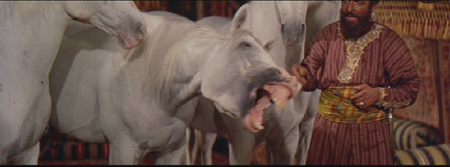
"I am Lipizzaner; hear me attempt to roar!"
The small
scene, nestled amidst battles and atrocities, is all the more powerful for its
limited scope.
cup of water. He may have gone on to his revenge successfully, but he would
have been lacking that part of his spirit that makes revenge distasteful, that
centers the moral of the whole film. The external conflict is already
well-defined, and now the internal has come alongside:
this kindness.
The
portrayal of Jesus throughout Ben-Hur is admirably understated. His
face is never shown; his voice is never heard. He stands apart from dogma as
nothing more than a guy who thinks it would be awfully neat if we were all nice
to one another, and, in practice, his attitude is effective. If you dislike
religious movies and Biblical epics on personal grounds, this is the one you
should make an exception for, because of the distinction between religion and
ideology.
The
progression of time during the second act, during which Judah escapes from
slavery and prepares for his return to Judea and confrontation with Messala, is
the only glaring rough aspect of the film. The editing is uneven, particularly
across spans of time. With a few quick cuts, seemingly continuous,
slave, and then several months as a personal servant to a high-ranking Roman
official. During this time, his desire for vengeance is rendered down to its
essentials: his vendetta isn’t against Rome as a whole — in fact, he rescues
his Roman benefactor from drowning, and attributes the action to Jesus’
influence at the well in Nazareth. Judah’s focus is narrow; it is Messala alone
he wants his revenge against.
Depending
on your approach to the film, this tunnel vision of Judah’s may undermine one
of the film’s subplots. Up until this point, there has been a passive
condemnation of empire building from the filmmakers. As Judah returns to Judea,
though, the narrative eye zooms in too closely to comment further on the Roman
Empire as analogue to modern countries.
This point
is where the first disc ends. Another potential fault of this set is that the
second disc doesn’t immediately pick up at the entr’acte, but instead forces
the viewer to sit through the Warner Brothers logo again, and make a selection
from a main menu. This swapping of discs doesn’t break up the flow of the
narrative, since the orchestral intermission and entr’acte have already done
so, but it is an unnecessary annoyance. Any of the Lord of the Rings: Extended
Editions show how it could be done better.

That morning, he had been your average stuntman.
By afternoon, he was the King of Cyprus. By nightfall, he would be dead.
The
second disc spends a solid half of its running time dealing with the great
chariot race, the field on which Judah holds his final battle with Messala. Upon
returning to Judea, Judah is told that his mother and sister have died in the
dungeons. The race becomes the perfect opportunity for Judah to exact his
revenge, as we are told that there are no laws on the circus.
The race
itself remains one of the great cinematic action sequences of all time. It
features absolutely no music, relying instead on the cheers of the crowds and
the sounds of pounding hooves to support the visuals. It’s a massive spectacle,
oft-imitated in modern films (the pod race in The Phantom Menace, for
brief and sad example), and as engaging to jaded eyes as it is to fresh. Judah
races with a fury that demands his bared teeth; Messala is a raging bastard
whose sawblade wheels were always an icon of film to my young mind.
I
highlight the lack of score in this sequence, but it is worth noting that the
score, composed by Miklos Rozsa, is nothing short of perfection. Rozsa takes a
thematic approach similar to opera, with themes not for characters but for
emotions; these themes get shuffled around, overlapping different characters at
different times, and always are tied to whatever feeling Wyler wanted to
emphasize in any given scene. Including the overture, intermission, and
entr’acte also serves to smooth over the audience’s submersion in the film, as
they are already familiar with the themes by the time the characters first
appear on screen, and have a direct point of contact.
After the
chariot race, Judah’s thirst for vengeance is slaked. The exterior conflict is
resolved, leaving the interior conflict more ragged than ever. The long
comedown between accepting the crown of laurels as victor of the race and
winding up at Golgotha returns to the state of Judah’s spirit, drawing
parallels between his time as a slave and his intentional slavery to revenge.
The film neatly sidesteps all pedantry by having Judah project his interior struggle
onto his mother and sister, both very much alive but stricken by leprosy.
Together, they decide to travel to Jerusalem, to meet a man from Nazareth who,
they say, has been performing miracles for the people, in the hope that he
might cure the disease.
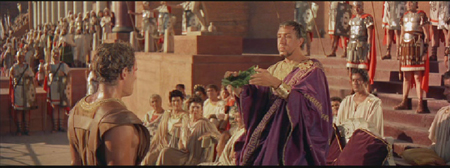
King Herod– er, Pontius Pilate bestows a laurel wreath upon Moses– er, Judah Ben-Hur.
The
conclusion isn’t hard to spot coming, and it takes its sweet time on the
approach, but, as before, the deliberate pace only serves to heighten the
connection to the characters; the plot is never dragged down the point of
boredom. This resolution, with Judah and his family arriving too late to speak
with Jesus before his crucifixion, is another stab from fate, just like the
broken roofing tile that started the whole mess.
It is
rumored that Burt Lancaster turned down the role of Judah because he didn’t
approve of the film’s apparent morality of violence. If that’s not just
hearsay, then Lancaster didn’t read the role very closely, or perhaps gave up
after the chariot race. In a moment when it seems that a moral of violence
could very well be the intention of the filmmakers — condoning revenge as a
worthy goal as Judah beholds the Romans brutalizing Jesus as they did him when
he was a slave — we are brought to another repetition, this time the kindness
of a cup of water. Judah kneels before the bloody Christ on the cobblestones
and holds out a drink to a man who, as far as Judah knows, is nothing more than
a good man. As he follows the crucifixion parade, Ben-Hur comes to a brutal
realization that might be a bit dogmatic for some, but is thought-provoking
nonetheless: he shares many traits with his Roman enemies, and the traits he
shares are the very ones that sentenced Jesus to death.
That
sounds like a downer of an ending, and it would be if that realization did not
imply that Judah had just found salvation, not just in turning from his
consumption by anger, but also in a stricter, more religious sense. It’s a
truer, more believable salvation story than that found in any other Biblical
epic. Judah’s life is not one of greatness, despite his laurels and wealth; he
leaves no impact on the world and, as far as we know, he leaves it a slightly
worse place than he found it; but his life and his salvation are so captivating
to watch because, just like that cup of water Jesus gave to Judah at the well,
it’s so small in the grand scheme of things, so damn unimportant.
9.5 out 10
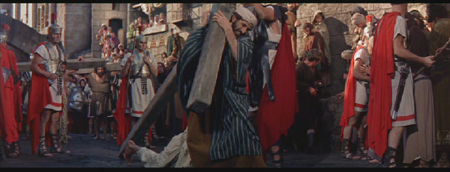
What would Joseph of Arimathea do? He’d get played like the tool he is, that’s what he’d do.
The Look
Presented
in ultra-wide 2.76:1 aspect ratio from a 65mm print, every shot is gorgeous and clear.
The original print was 70mm, with 5mm used for the magnetic soundtrack next to
the sprockets. The negatives were 65mm, and the amount of clarity is often
breathtaking on a good display. Close-ups and establishing shots are both used
to great effect, balancing the intimacy of the film with its epic scope, and
neither gets the short end of the stick.
With such
a great resolution, it’s a snap to pick up on the few out-of-place elements,
such as the matte painted backdrops. Some of the soundstage sequences were set
against massive painted screens mimicking Judean countryside, Rome at night, et
cetera. The problem is that with such a detailed transfer, these
two-dimensional pieces of art look exactly like what they are: giant, flat
pieces of canvas. They weren’t distracting enough to destroy the suspension of
disbelief for this critic — and I actually rather enjoyed seeing them, as
hallmarks of grand cinematic tradition — but they might grate on some viewers.
9 out of 10
The Noise
As with
the visuals, I can find little fault with the soundtrack on this set. In the
standard Dolby Digital 5.1 surround, the music, dialogue, and effects mesh
perfectly, no one portion dominating any of the others. There is a real warmth
to the sound editing, a succession of carefully chosen cues that soften the
tone of the film.
The
musical score contributes mightily to the film’s emotional connection to the
audience, as I touched on above. Despite having no clue of what Roman music may
have sounded like, Rozsa came up with a score that possesses all the drama, all
the flair, and all the decadence that we imagine that culture would have
reflected in their music.
The
addition of the music-only track on the first two discs is a real joy, which I
will explore in more depth below.
The only
gripe I can manage to put down with any authenticity is that some of the effects
seem to have been captured poorly from the original track. The sea battle, as
Judah’s galley engages a Macedonian fleet, features a number of clanging sword
strikes that have a touch of the old tin can to them.
9 out of 10
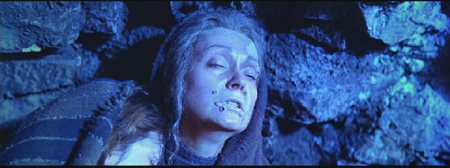
Long before the invention of black felt.
The Goodies
Discs 1 & 2:
This is a
quality set when it comes to the extras. It’s packed, Lord of the Rings-style
with a good commentary, a music-only track, a disc full of documentaries and
other features and, oh why the hell not, an entire disc devoted to a bonus
feature-length film, the 1925 silent version of Ben-Hur.
The
William Wyler version of the film is spread out over two discs, neatly divided
across the included intermission and entr’acte. The extra room on each disc is
filled up with the gorgeous visuals and sound mentioned above, as well as the
commentary track, which features film historian T. Gene Hatcher with occasional
interjections by Charlton Heston. As with most tracks by people not involved
directly in the production, Hatcher’s commentary is a bit distant, an analysis
of the cinematic qualities of the film rather than intimate memories of the
creation of the film. Hatcher has plenty of good things to say; for the
intimacy we get Heston’s infrequent, laconic impressions of Wyler, of the
production.
Charlton
Heston is not an intimate man. So, this commentary treats the film as an object
worthy of dissection, which it certainly is, but the unemotional voices may
leave some viewers cold.
The disc
has a third track, consisting of just the score. As mentioned above, the score
is as much a work of art as the film itself, and this music only track serves
to emphasize both those points. Without dialogue, the visual aspects of the
film are emphasized; likewise, without dialogue, the emotional beats of the
music are more evident.
Disc 3:
The 1925
silent version is on disc three, presented in its original full-frame aspect
ratio. The restoration on this print is incredible; it’s among the best of the era
that I have seen on DVD. The contrast balance is just right in the black and
white sections (emphasizing those lipsticked men), and in the few brief
technicolor sequences, the color is vibrant, and the grain is almost
nonexistent.
It might
be more difficult for a viewer to get into, as much of the action was recorded
at twenty or fewer frames-per-second and we’re getting a digital transfer from
twenty-four frames-per-second playback, which makes a lot of motion seem as if
it were performed by birds or squirrels.
The plot
of the silent version deviates slightly from that of Wyler’s version — I’m
afraid I can’t reconcile either with the novel, since I haven’t read it. The
silent version has a greater dependency on the incorporation of Christian
tropes, and even frequent title cards bearing snippets of scripture, whereas Wyler’s
version makes the assumption that the audience is already familiar with the
mythology and doesn’t waste time with unnecessary exposition. The silent
version is an achievement of its own, though, and well worth the watching,
especially for its take on the chariot race. Also, Judah’s manly legs spend
most of the film in a skirt.
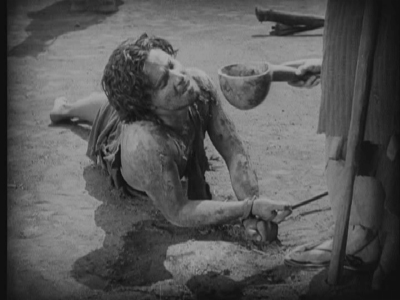
What was it about Jesus that made him so special? Was it his kindness, his gentleness?
Was it the subtle way his arms jutted from his kneecaps?
Disc 4:
The
fourth disc contains the remainder of the bonus material: two documentaries, a
photo montage, archived theatrical trailers, selected screen tests, vintage
newsreels, and snippets from the 1960 Academy awards in which Ben-Hur
won 11 Oscars.
The first
documentary is a 2005 feature called "Ben-Hur: The Epic That Changed
Cinema." It features interviews with numerous filmmakers and film
historians reminiscing on the history, context, and impact of Ben-Hur.
Nearly everyone has something interesting to say, except for George Lucas whose
comments — out of context, I’m sure — consist of him saying how great Star
Wars is. A wide range of filmmakers are surveyed, showing the high
regard that Hollywood has for Ben-Hur, its cinematography, its
music, its acting, and its directing. It’s a circle-jerk, but not unwarranted.
The
second documentary has more meant to it. It was made in 199 and is more about
the production of the film. The gestation of the film is chronicled, with
sections on not only the 1925 silent version, but also a 1907 short version. We
are presented with a number of interesting bits of trivia from those involved
with the production; of special interest are writer Gore Vidal’s recollections.
Vidal was hired for a script re-write, and during his reviewing of the early
scenes, he thought that Judah and Messala’s meeting was missing something. He
proposed to Wyler that the actors play the scene as a lover’s quarrel, rather
than a simple falling-out between friends. The homoerotic undertones are
present in the film, but Vidal did not get a screenplay credit.
This is a
lengthy and interesting documentary, and covers well more than gay sex,
including special effects, the matte shots, the score, and a full chapter
devoted to the chariot race.
There are
also four screen tests (featuring a young Leslie Nielson in the role of
Messala!); a photo montage, set to music, which follows the production; an archive
of theatrical trailers; a gallery of newsreels from the era of the film’s
release; and highlights from the 1960 Academy Awards ceremony, in which Ben-Hur
collected awards for eleven of the twelve categories in which it was nominated
(Best Screenplay being the only one it missed out on).
There’s
enough on these bonus discs to keep a viewer busy for hours, and only the
barest amount is fluff.
9.5 out of 10
The Artwork
Absolutely
gorgeous. The old red-and-orange cover from posters and the VHS release is
redone here with an excellent colorization. The sky is given definition, and
all the elements are retained and emphasized. The memorable stone text is as
solid and dramatic as ever. The result is a majestic interpretation of an
iconic image.
9 out of 10
Overall: 9 out of 10